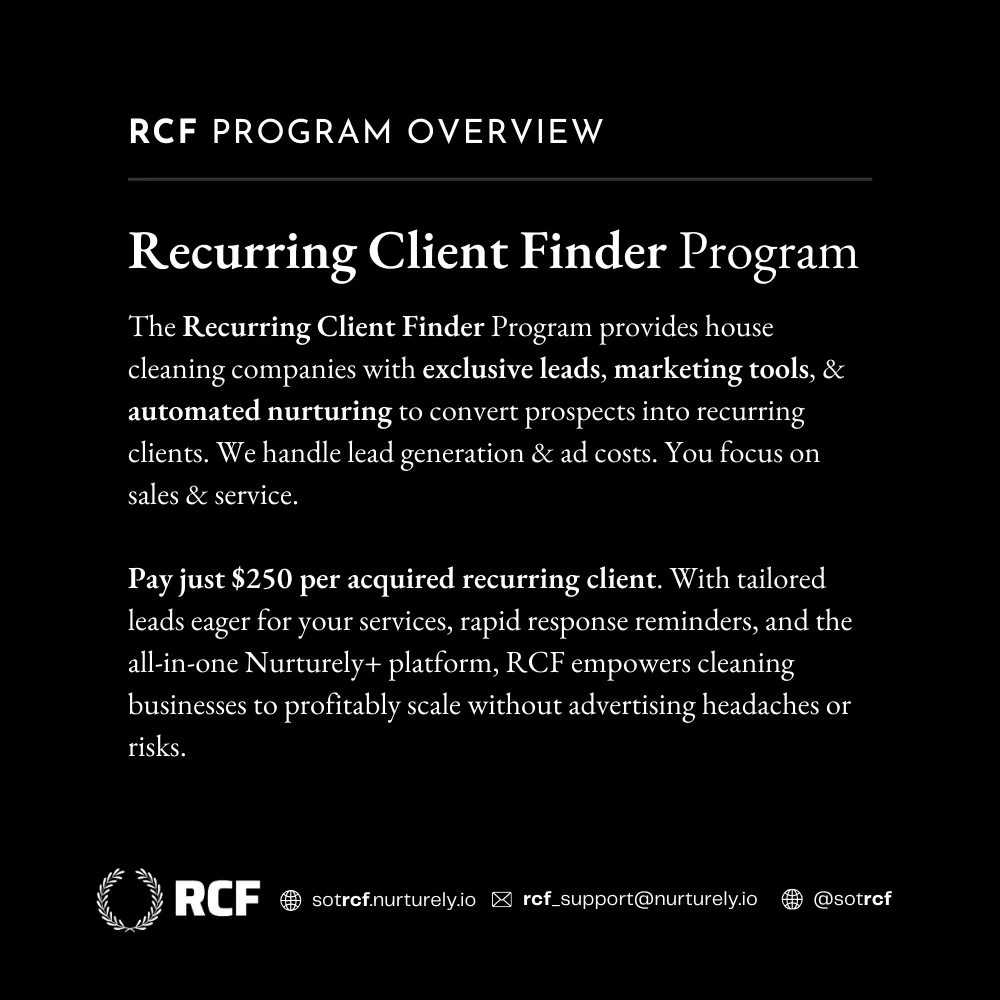
Buying Clients
"Whoever can spend the most to acquire a customer, wins." — Dan Kennedy
Dan Kennedy famously said, "Whoever can spend the most to acquire a customer, wins."
It's a straightforward idea that resonates across many industries, including house cleaning. In this extraordinarily competitive field, the ability to invest wisely in attracting new clients can make a significant difference.
Think about it: If you can afford to put a little more into finding new customers, you can outpace your competitors, growing your client base and your business.
And when it's a recurring client on the line, we're all hands on deck.
Understanding the Cost of Customer Acquisition
Customer Acquisition Cost (CAC) is a crucial metric in any marketer's toolkit, representing the total cost spent on acquiring a new customer. Understanding and managing this cost is especially important due to the competitive nature of the market and the need for continuous client acquisition to maintain steady revenue streams.
For instance, a business heavily utilizing digital marketing might experience different costs compared to one relying on traditional methods like flyers or local advertisements.
Investing in customer acquisition isn't just about spending money; it's about strategically investing to see a return in the form of long-term profitability.
According to DigitalMarketer's five-step CAC formula, businesses should calculate their CAC by considering the revenue generated from a customer over their lifetime, then subtracting associated costs such as refunds, cost of goods sold (COGS), and overhead.
Determining A Healthy Acquisition cost (CAC)
Determining a healthy Customer Acquisition Cost (CAC) for a company involves several key steps and considerations. It's not simply about finding a low number, but rather understanding what CAC means in the context of your business's overall financial health and strategic goals. Here’s a detailed approach to figuring out a healthy CAC:
Calculate Your Current CAC: First, you need to know your current CAC, which is calculated by dividing the total costs associated with acquiring new customers (including marketing and advertising expenses) by the number of customers acquired in the period those costs were incurred.

Understand Customer Lifetime Value (LTV)
Knowing the lifetime value of a customer is crucial. LTV is the total revenue you expect from a customer over the duration of their relationship with your business. A healthy CAC should be significantly lower than the LTV to ensure profitability.
The LTV:CAC ratio is a key metric; many businesses aim for a ratio of 3:1 or higher, meaning the lifetime value should be at least three times the acquisition cost.
Benchmark Against Industry Standards
Look at industry benchmarks for CAC. These can vary widely depending on the sector, the economy, and customer base.
For example, B2B companies often have higher CAC than B2C due to the higher costs of personal selling and longer sales cycles.
Consider Profit Margins
Factor in your profit margins. If your margins are high, you might be able to sustain a higher CAC.
Businesses with lower margins need to keep a tighter rein on acquisition costs to remain profitable.
Evaluate the Sales Cycle
Long sales cycles can affect CAC because costs accumulate over a longer period before a customer is acquired.
If your sales cycle is long, you might need to adjust expectations and strategies regarding CAC.
Analyze Growth & Market Conditions
Consider your company’s growth stage and market conditions.
Startups, for example, might tolerate a higher CAC initially as they invest in growth and market penetration, but this should decrease over time as brand awareness and customer base grow.
Regular Review & Optimization
Continually review and optimize your CAC. Test different marketing strategies to see which provide the best return on investment (ROI).
Use analytics to track which channels and tactics yield the lowest CAC while still bringing in qualified customers.
Integrate with Business Goals
Align CAC with broader business objectives. If the goal is to quickly increase market share, a higher, more aggressive CAC might be acceptable temporarily.
However, for sustainable growth, finding ways to lower CAC or increase LTV is essential.
Customer Segmentation
Consider that CAC can vary by customer segment.
Tailor your marketing efforts to target the most profitable segments more effectively, potentially lowering your overall CAC.

Strategies to Maximize Your Marketing Budget
Maximizing your marketing budget is key to achieving the best possible returns on your investment, especially in the house cleaning industry where every dollar counts. Here are practical tips and strategies that can help you allocate your marketing resources more effectively:
Diversify Your Efforts: Don't put all your eggs in one basket. Allocate your budget across various channels such as PPC (Pay-Per-Click), SEO (Search Engine Optimization), and social media to find what gives you the best results. This approach reduces risk and increases the potential for finding the most cost-effective methods.
Invest in PPC: Pay-Per-Click advertising can be particularly effective for house cleaning services because it targets customers at the moment they are searching for these services. Platforms like Google Ads and Bing provide tools to manage your campaigns and set budgets that do not exceed your limits.
Optimize for SEO: Investing in SEO can yield long-term benefits by increasing your visibility in search engine results naturally. Focus on keywords that potential customers might use to find services like yours, such as "house cleaning services in [Your City]" or "best maid service near me."
Engage on Social Media: Social media platforms are great for connecting directly with potential clients. They offer tools for targeted advertising, but they are also venues for sharing useful content, engaging with users, and managing customer service inquiries, all of which can enhance your brand's reputation.
Monitor and Adjust: Use analytics tools to track the performance of all your marketing activities. Tools like Google Analytics or insights provided by social media platforms can tell you what’s working and what’s not. Regularly reviewing these metrics allows you to adjust your strategies in real-time, optimizing your budget for the best returns.
Building Relationships & Trust
Trust is the cornerstone of any successful service-based business, particularly in the house cleaning industry.
The intimate nature of the service, which involves entering clients' personal spaces, heightens the importance of building and maintaining trust.
Here’s how you can establish trust as a fundamental part of your client relationships, which will aid in both acquisition and retention:
Transparency in Communication: From the outset, be clear about your services, pricing, and policies. Honest communication helps set realistic expectations and reduces misunderstandings that could erode trust.
Reliability & Consistency: Clients rely on you to provide consistent, high-quality service. Regularly meeting or exceeding expectations with reliability reinforces trust, encouraging clients to stick with your service over time and even upgrade or add services.
Personalization: Tailor your service to individual client needs and preferences. Remembering details like a client’s preferred cleaning products or specific cleaning instructions shows that you listen and care, personalizing their experience and strengthening their trust in your service.
Request & Act on Feedback Promptly: Show that you value your clients’ opinions by soliciting feedback through surveys or direct communication. More importantly, act on that feedback to demonstrate your commitment to continuously improving their experience.
Reward Loyalty: Implement a loyalty program or offer special promotions to long-term clients. Recognizing and rewarding client loyalty not only reinforces their decision to choose you but also encourages them to share their positive experiences with others.
Encourage Referrals: Referrals are a powerful tool in the house cleaning business. A recommendation from a trusted friend or family member can be more persuasive than any advertisement. Encourage satisfied clients to refer others by offering referral discounts or other incentives.








Facebook
Instagram
X
LinkedIn
Youtube
TikTok